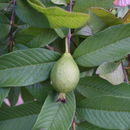en
names in breadcrumbs


Guava (Psidium guajava) is a well known cultivated tree because of the paste and jelly made from its fruits. The fruit (which is technically a type of berry) has a thin, yellow, slightly sour edible outer layer; within, there are numerous yellow seeds more than 3 to 5 mm long in a juicy pinkish or yellow pulp. The fruits are unusually rich in vitamin C. The outer layer of the fruit is preserved and canned commercially, as is the juice. (Little and Wadsworth 1964)
Guava is native to tropical America, probably from southern Mexico south to South America, but its range has been dramatically increased via cultivation. It is now cultivated (and escaped and naturalized and often considered an invasive pest) in southern Florida (including the Florida Keys), Bermuda, and throughout the West Indies from the Bahamas and Cuba to Trinidad, and south to Brazil. It is also cultivated and naturalized in much of the Old World tropics and subtropics. (Little and Wadsworth 1964) Guava was first recorded from the Pacific Islands (Hawaii) by the early 1800s (Whistler 1995). It is common in dry to wet disturbed areas such as pastures, waste places, and roadsides, as well as in scrub forest up to 1200 meters elevation, among other habitats.
Guava is a shrubby evergreen tree up to 10 meters in height, with smooth reddish brown bark that is thin and scales off in thin sheets. It has oppositely arranged oblong or elliptic leaves with sunken parallel veins and minute glandular dots. The fragrant white flowers are large, measuring about 4 cm across the 4 or 5 large petals, and bear numerous showy brushlike stamens with slender white filaments averaging about 1.2 cm long. The flowers are mostly borne singly at leaf bases. The edible fruits are yellow and rounded (sometimes pear-shaped), 3 to 10 cm in diameter, with 4 or 5 retained sepals at the apex. (Little and Wadsworth 1964; Whistler 1995)
The related Strawberry Guava (Psidium cattleianum) is another native of tropical America that has spread widely in the tropics, including the Pacific Islands (where it was first recorded, in Hawaii, in 1825) and southern Florida (U.S.A.). Like P. guajava, it is often considered an aggressive weed. It has leathery leaves and the fruit (generally much smaller than that of P. guajava) is red (sometimes yellow) with a white pulp. (Whistler 1995)
Guava (Psidium guajava) is native to tropical America, probably from southern Mexico south to South America, but its range has been dramatically increased via cultivation. It is now cultivated (and escaped and naturalized and often considered an invasive pest) in southern Florida (including the Florida Keys), Bermuda, and throughout the West Indies from the Bahamas and Cuba to Trinidad, and south to Brazil. It is also cultivated and naturalized in much of the Old World tropics and subtropics. (Little and Wadsworth 1964) It was first recorded from the Pacific Islands (Hawaii) by the early 1800s (Whistler 1995).
In the Pacific Islands, Guava (Psidium guajava) is common in dry to wet disturbed areas such as pastures, waste places, and scrub forest up to 1200 meters elevation (Whistler 1995). In Puerto Rico, it forms thickets and spreads in pastures, especially on the coastal plains but also in the lower mountain regions (Little and Wadsworth 1964). In southern Florida, it now grows wild along roadsides, in old fields, and in hardwood hammocks (Elias 1980), among other habitats.
The Strawberry Guava (Psidium cattleianum) is another native of tropical America that has spread widely in the tropics, including the Pacific Islands (where it was first recorded, in Hawaii, in 1825) and southern Florida (U.S.A.). Like P. guajava, it is often considered an aggressive weed. It has leathery leaves and the fruit (generally much smaller than that of P. guajava) is red (sometimes yellow) with a white pulp. (Whistler 1995)
In southern Florida and the Caribbean, the native P. longipes is more rarely encountered than P. guajava. Compared with P. guajava, it has smaller leaves (with tips sometimes notched) and the much smaller ripe fruits are dark rather than yellow. (Elias 1980; Petrides 1988)
Other Psidium species are found in Mexico and Central and South America.
Guava (Psidium guajava) is a shrubby small evergreen tree (rarely with straight stems) up to 10 meters in height, with smooth reddish brown bark that is thin and scales off in thin sheets. It has oppositely arranged oblong or elliptic leaves with sunken parallel veins and minute glandular dots. The fragrant white flowers are large, measuring about 4 cm across the 4 or 5 large petals, and bear numerous showy brushlike stamens with slender white filaments averaging about 1.2 cm long. The flowers are mostly borne singly at leaf bases. The edible guava fruits are yellow and rounded (sometimes pear-shaped), 3 to 10 cm in diameter, with 4 or 5 retained sepals at the apex. (Little and Wadsworth 1964; Whistler 1995)
Guava (Psidium guajava) flowers and fruits nearly year-round (Little and Wadsworth 1964).
In the Pacific Islands, Guava (Psidium guajava) was originally introduced for its edible fruit, but is now a serious weed in pastures and elsewhere (Whistler 1995). It is considered invasive in Florida, as well (Gann et al. 2008).
Guava (Psidium guajava) is commonly cultivated as a fruit tree. The fruit (which is technically a type of berry) has a thin, yellow, slightly sour edible outer layer; within, there are numerous yellow seeds more than 3 to 5 mm long in a juicy pinkish or yellow pulp. The fruits are unusually rich in vitamin C. The outer layer of the fruit is preserved and canned commercially, as is the juice. Guava powder has been prepared from the dehydrated fruits as well. In some regions, the bark has been used for tanning. Extracts from leaves, bark, roots, and buds have been used in folk medicine. (Little and Wadsworth 1964)
Guava leaves are often boiled into a tea to treat diarrhea on many of the Pacific Islands (Whistler 1995).